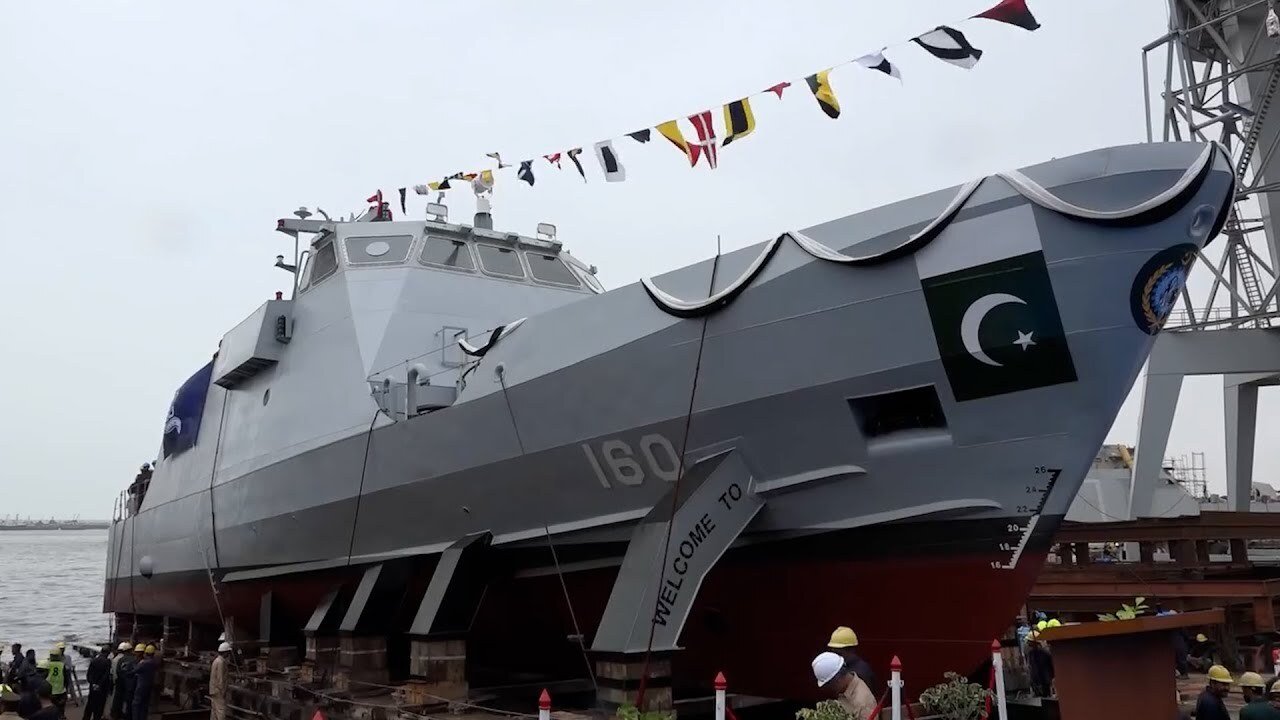Pakistan Navy Commissions New Built Gunboat for Coastal Defense

A Landmark Achievement in Indigenous Naval Power
In a major step toward defense self reliance, the Pakistan Navy commissions a new, locally built gunboat, significantly strengthening the country’s maritime security and patrol capabilities. The state of the art vessel was formally inducted during a ceremony held at Karachi Shipyard & Engineering Works (KSEW), where senior naval leadership praised the milestone as a symbol of Pakistan’s growing industrial and military strength.
This latest addition is part of a broader strategy to modernize the naval fleet with a strong focus on indigenous shipbuilding. As the regional maritime landscape continues to evolve, the gunboat’s arrival comes at a crucial time serving both strategic and symbolic value.
Pakistan Navy Commissions Advanced Gunboat Built Entirely in Pakistan
The fact that the Pakistan Navy commissions this new gunboat from a local facility is a direct result of the country’s vision for technological independence and defense sustainability. The vessel, named PNS Harbah, was fully designed and constructed at KSEW using advanced naval engineering practices, making it a flagship project of domestic capability.
Rear Admiral Imran Ahmed, speaking at the commissioning ceremony, said, “The Pakistan Navy commissions this powerful platform as part of its mission to protect maritime sovereignty, support economic infrastructure, and ensure the safety of our sea routes.”
He added that the project reflects Pakistan’s shift from procurement dependence to production empowerment—a move seen as crucial for long-term defense readiness.
Technical Highlights: Agile, Armored, and Ready
The newly commissioned gunboat boasts a host of impressive technical specifications tailored for rapid response missions and littoral warfare. Among its features:
-
Displacement: 500–600 tons
-
Top Speed: Over 30 knots
-
Weapons: Equipped with surface to surface missiles, a 30mm main gun, and heavy machine guns
-
Technology: Integrated electronic warfare and radar systems
-
Crew Capacity: 40 to 50 naval personnel
The platform has been engineered for versatility, capable of participating in coastal patrols, anti piracy operations, port security, and defense support during national emergencies.
With the addition of this new asset, the Pakistan Navy commissions a tool designed for both conventional and asymmetric maritime threats, especially in shallow water zones and critical sea lanes.
Indigenous Shipbuilding: A National Priority
The success of this project reinforces the growing role of indigenous production in Pakistan’s national defense strategy. The Pakistan Navy commissions vessels like PNS Harbah to not only enhance its operational reach but also to build long-term industrial strength through skill development, job creation, and technical training.
Karachi Shipyard has been central to these efforts. Over the past decade, it has upgraded its design and manufacturing facilities to accommodate both military and commercial shipbuilding needs. The facility’s collaboration with Pakistan Navy, as seen in this project, symbolizes the synergy between defense users and industrial producers.
The Ministry of Defence Production also sees this as a step forward in realizing the goals of “Make in Pakistan,” an initiative that promotes local production in all sectors, including defense.
Strategic Significance in a Changing Maritime Landscape
At a time when regional maritime competition is intensifying, the Pakistan Navy commissions assets that are flexible, fast, and reliable. This new gunboat enhances the Navy’s ability to operate in Pakistan’s 1,000 km coastline, the Arabian Sea, and its Exclusive Economic Zone (EEZ).
Maritime analysts believe the deployment of such assets is timely. With the increasing importance of the China Pakistan Economic Corridor (CPEC), including operations at Gwadar Port, Pakistan must ensure constant maritime vigilance.
The newly commissioned vessel is expected to carry out patrol duties in these critical zones, ensuring the uninterrupted flow of trade and the protection of underwater infrastructure.
Strengthening Maritime Defense for the Future
This move is not an isolated case. Over the past few years, the Pakistan Navy commissions multiple types of ships, submarines, and auxiliary vessels as part of its comprehensive modernization plan. With a balanced mix of surface and sub-surface platforms, Pakistan aims to achieve regional naval parity and strengthen blue-water operations.
Recent years have seen the commissioning of:
-
Tugboats and small crafts
-
Offshore Patrol Vessels (OPVs)
-
Modern Frigates under the MILGEM project with Turkey
-
Fully indigenous Fast Attack Craft (FACs)
The Navy’s long term vision includes expanding this trend further. Indigenous platforms will continue to play a leading role in future naval development, both in terms of warfighting and logistics support.
What Makes This Gunboat Stand Out
Compared to its predecessors, PNS Harbah integrates newer propulsion systems and lightweight alloys, making it more fuel-efficient and mission-adaptable. Its design is compact but durable allowing it to navigate narrow channels and respond quickly to emergency alerts.
Naval sources confirm that the Pakistan Navy commissions gunboats like these not only for defense but also to assist with civil maritime security. This includes supporting law enforcement agencies, coastal surveillance teams, and anti-smuggling operations.
The gunboat is expected to be deployed in the southern coastal command of Pakistan Navy, where it will join other high-speed vessels already operating under the Coastal Security Force.
Domestic and International Reactions
Defense analysts and former naval officers have welcomed the development. Brigadier (R) Syed Mazhar, a defense strategist, noted, “Every time the Pakistan Navy commissions an indigenous platform, it sends a message of resilience. Pakistan is now not just a consumer of defense tech—it’s becoming a producer.”
Regional media outlets in China, Turkey, and the Middle East have also taken note of Pakistan’s naval strides. As maritime cooperation deepens across Asia and Africa, local shipbuilding capability gives Pakistan a strategic edge in forming security partnerships.
Moreover, countries interested in cost-effective patrol solutions have shown interest in KSEW’s production models. Exporting such platforms could become a reality in the future.
A Proud Moment for Pakistan’s Defense Sector
There’s no doubt that when the Pakistan Navy commissions a new warship, it reflects the growth of not just a military branch—but of an entire ecosystem. From skilled labor to advanced electronics, local industries play a central role in realizing such high-value projects.
This initiative also promotes national pride. Citizens recognize that domestic production means greater autonomy, better cost control, and safer technology handling.
Educational institutions like Pakistan Navy Engineering College (PNEC) and NUST are also contributing by aligning academic programs with defense needs, creating the next generation of naval engineers and designers.
Conclusion: A Giant Step Toward Self-Reliance
In conclusion, the fact that the Pakistan Navy commissions this locally built gunboat is a remarkable achievement. It’s a clear indicator of where the country is headed—toward a stronger, more self-sufficient military presence in the Indian Ocean Region (IOR).
By building and deploying its own vessels, Pakistan strengthens its sovereignty, reduces foreign dependency, and creates a resilient maritime defense force. This gunboat is more than steel and circuits—it’s a floating symbol of progress, vision, and determination.
As future naval developments unfold, one thing is certain: every time the Pakistan Navy commissions an indigenous vessel, it brings Pakistan closer to its goal of complete defense self-reliance.



